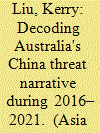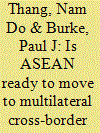|
|
|
Sort Order |
|
|
|
Items / Page
|
|
|
|
|
|
|
| Srl | Item |
| 1 |
ID:
191111


|
|
|
|
|
| Summary/Abstract |
Climate change education (CCE) can be an important tool to increase local community resilience. In 2017, the Pacific Community ratified the Framework for Resilient Development in the Pacific (FRDP) aiming to equip local communities with skills needed to become more climate change resilient. In 2018, Fiji implemented the Climate Change Resilience Programme (CCRP) at the University of the South Pacific (USP), the first of its kind in the South Pacific. This paper evaluates (i) the orientation and aim of the programme and (ii) how different stakeholders influenced the curriculum development process. Tribe's concept of curriculum space is used to highlight the overall aim of the CCRP. Freeman's stakeholder theory allows to identify key stakeholders and their influence on the curriculum. Results indicate that the programme seems to foster climate resilience in the workplace rather than the local community. Unfortunately, current and future community leaders, the notional targets of this course, were almost completely unrepresented in the process to accredit the course, with the body responsible for accreditation being dominated by industry representatives. This study helps to inform the current review of the Regional Certificate Programme to realign it with its initially envisioned community focus.
|
|
|
|
|
|
|
|
|
|
|
|
|
|
|
|
| 2 |
ID:
191115


|
|
|
|
|
| Summary/Abstract |
Australia–China relations began to sour in 2016, and the China threat narrative began to dominate since then. Unlike previous studies which either use a qualitative approach or cross-sectional dataset for empirical analysis, this study creatively creates high-frequency weekly and monthly time series datasets using the Google Trends search results during January 2016–February 2021. Based on a series of time series modellings, this study examines the roles of various actors, including China's own policies, the Australian Strategic Policy Institute and Clive Hamilton, various factors, including Chinese purchase of Australian housing, Chinese investment in Australia, Chinese students in Australia and China's rise and various media outlets, including the Australian Broadcasting Corporation, Australian Financial Review, Sydney Morning Herald, Daily Telegraph and Herald Sun, in contributing to Australia's China threat narrative. This study makes significant contributions to academia in methods by bringing a new quantitative approach to international relations studies and to policy-makers as well by quantifying the roles of various actors, factors and media outlets in Australia's China policy debate.
|
|
|
|
|
|
|
|
|
|
|
|
|
|
|
|
| 3 |
ID:
191106


|
|
|
|
|
| Summary/Abstract |
Using China Migrants Dynamic Survey Project data from 2012 to 2018, this paper evaluates the causal impact of equalisation of basic public health and medical services on the long-term urban settlement intentions of internal migrants by the difference-in-differences approach. The results reveal that the equalisation of basic public health and medical services has a negative impact on the long-term urban settlement intentions of internal migrants of 4%. Male, middle-aged, and unmarried internal migrants have a much stronger negative response, in terms of long-term urban settlement intentions, to changes in basic public health and medical services. Moreover, more recent internal migrants, those in first-tier cities and those in cities in eastern regions also have a much stronger negative response. Mechanism checks imply that the negative impact on the long-term urban settlement intentions of internal migrants is caused by social integration decline after implementation of equalisation of basic public health and medical services.
|
|
|
|
|
|
|
|
|
|
|
|
|
|
|
|
| 4 |
ID:
191114


|
|
|
|
|
| Summary/Abstract |
This paper reviews progress towards the establishment of an Association of Southeast Asian Nations (ASEAN) Power Grid (APG) and the key barriers to multilateral cross-border electricity trade in ASEAN. An analysis across political, technical, institutional, economic, environmental, social and time dimensions is employed. Using a policy sequencing framework, the paper concludes it remains premature for ASEAN to pursue a strong form of power sector market integration on account of the sizeable barriers that currently remain, especially economic and institutional barriers. Focusing on bilateral power purchase agreements and large-scale investments in solar and wind power over 2022–2030 would help to develop stronger foundations for ASEAN to make steps towards deeper regional integration in the electricity sector in subsequent years, while also being consistent with renewables adoption goals.
|
|
|
|
|
|
|
|
|
|
|
|
|
|
|
|
| 5 |
ID:
191108


|
|
|
|
|
| Summary/Abstract |
Although the influence of mobility on place attachment has received attention in the literature, this relationship varies between groups. Unlike those who move to enjoy their retirement, for example, older migrants arriving in Shenzhen come to the city ‘passively,’ drawn by the needs of their children. This paper advances understanding of the concept of place attachment by illustrating the relationships between its components. Analysis of interview and questionnaire responses revealed the following relationships between three focal components of place attachment. Place dependence first directly influenced affective attachment and then indirectly affected place identity. Leisure involvement had a positive impact on place dependence and affective attachment but no direct effect on place identity. Residential satisfaction was an antecedent of all three focal dimensions of place attachment. No direct relationship was found between leisure involvement and residential satisfaction.
|
|
|
|
|
|
|
|
|
|
|
|
|
|
|
|
| 6 |
ID:
191110


|
|
|
|
|
| Summary/Abstract |
Later-life migrants, as older people living away from their home nations, occupy multiply-precarious positions in relation to national COVID-19 pandemic responses. Concern has particularly centred on this group's increased risk of social and linguistic exclusion. We explore the perspectives of later-life older Chinese and Koreans living in New Zealand during the nation's COVID-19 lockdown of 2020. This paper presents a sub-analysis of culturally-matched interviews conducted with 3 Korean and 5 Chinese later-life migrants. These participants are a sub-sample of a larger qualitative interview study comprising 44 interviews. A social capital approach has been used to aid conceptualisation of participants' experiences and a reflexive thematic approach guided analysis. Despite their underrepresentation in national response efforts, Chinese and Korean later-life migrants resourcefully participated in ethnically-specific pandemic initiatives. Three themes identified were: (1) taking it seriously (2) already digitally literate (3) challenges and difficulties. Older Asian migrants engaged in a range of creative strategies to stay connected during COVID-19 lockdowns which drew heavily on pre-existing social capital. Future pandemic responses should seek to improve connectedness between the national government COVID-19 response and older Korean and Chinese later-life migrants.
|
|
|
|
|
|
|
|
|
|
|
|
|
|
|
|
| 7 |
ID:
191107


|
|
|
|
|
| Summary/Abstract |
There is no consistent conclusion on the impact of improving the physical accessibility of medical facilities/resources on the utilisation of medical facilities and health outcomes, which may be due to neglecting the role of spatial cognition of physical facilities, which will be directly related to health behaviour and outcomes. This article uses China Migrants Dynamic Survey to examine the relationship between perceived accessibility of medical facilities and health and health behaviour. The results show that perceived accessibility is positively associated with health and related behaviour. The higher the perceived accessibility to the medical facilities, the better the subjective and objective health status of migrant residents. Similarly, the more positive the preventive and healthcare-seeking behaviour is. This study suggests that public policymakers need to intervene in residents' spatial cognition of medical resources around their neighbourhoods to enhance the collective benefits of medical facilities.
|
|
|
|
|
|
|
|
|
|
|
|
|
|
|
|
| 8 |
ID:
191109


|
|
|
|
|
| Summary/Abstract |
As COVID-19 has caused unprecedented social change, governments are implementing several social measures to control transmission. Among them, social distancing is being enforced in almost all countries and is effective in preventing infection. Based on the importance of social distancing, this study identifies factors influencing the intention towards social distancing. The research model was developed by introducing risk perception in the theory of planned behaviour. To examine the proposed model, a survey was conducted with 339 university students from two countries, South Korea and Vietnam. The data were analysed using the partial least squares method. The results show that social distancing attitude and perceived behavioural control significantly influence social distancing intention. The findings indicate that both affective risk perception and cognitive risk perception serve as imperative factors in the formation of social distancing attitudes, subjective norms and perceived behavioural control. However, subjective norms and nationality do not affect social distancing intention. Based on the results, suggestions are made for policymakers to establish effective social measures.
|
|
|
|
|
|
|
|
|
|
|
|
|
|
|
|
| 9 |
ID:
191113


|
|
|
|
|
| Summary/Abstract |
There is a consensus among small Pacific islands that the extent to which they benefit from international tourism largely depends on how much of the value created by tourism remains in the local economy. This study examines how the value created in the hotel industry is distributed among the key stakeholders in a small Pacific island context. We used aggregated income statements of full-service and limited-service hotels from the STR Inc., a hotel industry data company, to calculate the value distribution among the key stakeholders in the hotel industry of a small Pacific island. We found that labour and owners captured most of the value created, whereas hotel management companies and franchisors captured a small share of the value. Our results suggest that tourism workers' ability to take united action and hence to negotiate higher wages will result in higher value capture by local labour and less value leaking out of the local economy. Our results also reveal that foreign ownership in the hotel industry is the single largest cause of economic leakages. The study has several implications for the tourism-based growth policies in small Pacific islands.
|
|
|
|
|
|
|
|
|
|
|
|
|
|
|
|
| 10 |
ID:
191112


|
|
|
|
|
| Summary/Abstract |
The tourism industry has long been recognised for supporting women in achieving economic empowerment and social freedom through entrepreneurial and employment opportunities. Widely recognised as a women-dominated sector, tourism is deemed to be a facilitator of women's development following the UN Sustainable Development Goals (SDGs). As the existing literature suggests, women's involvement in tourism activities supports local economic growth and development, while facilitating social transformation that enables them to create their own identities. Despite these achievements, several studies noted the persisting issues women face in participating in tourism. With the goal of contributing to existing discourses, this paper aims to analyse their experiences in community entrepreneurship by examining several community-involved tourism enterprises in the Philippines. The findings of this study reveal that women have been largely involved in tourism activities in that country, yet their experiences working in these enterprises vary. The opportunities and challenges identified in this study can serve as a springboard for further analysis of the experience of women working in the Philippine tourism industry.
|
|
|
|
|
|
|
|
|
|
|
|
|
|
|
|
|
|
|
|
|